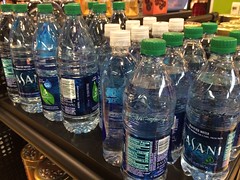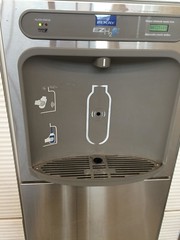 When people ask me about my research on the politics of bottled water, often times they will ask about ways in which they can change their individual behavior in order to reduce packaged water consumption. As I travel quite often for research and conferences, I have been realizing that there are several structural barriers to reducing bottled water consumption. That is, no matter how much we “activate” social norms and encourage individuals to shift consumption from water in a bottle to water from the tap, there are structural barriers that posit a challenge for anyone to change their own behavior. I will note two barriers in this post, specifically.
When people ask me about my research on the politics of bottled water, often times they will ask about ways in which they can change their individual behavior in order to reduce packaged water consumption. As I travel quite often for research and conferences, I have been realizing that there are several structural barriers to reducing bottled water consumption. That is, no matter how much we “activate” social norms and encourage individuals to shift consumption from water in a bottle to water from the tap, there are structural barriers that posit a challenge for anyone to change their own behavior. I will note two barriers in this post, specifically.
 The first one I noticed is the lack of infrastructure for refillable water bottles. This absence of refilling stations is also often coupled with a total failure in providing water fountains. I have noticed this at airports everywhere, but Mexico specifically. This is quite problematic given that Mexico is the top-ranked country in the world for per-capita consumption of bottled water. It is also one of the countries where bottled water companies are raking huge profits. Ironically, this problem (lacking water fountains and refilling stations) is not only present in airports, but also at schools (where we can often see young kids rush to purchase soft drinks) and local parks. My own research has confirmed what other authors have said: much of the rise in bottled water consumption can be traced to a lack of trust in tap water. This problem is also compounded by recent municipal water utility breakdowns, like the case of Flint, in Michigan. My good friend, coauthor and water governance specialist Oriol Mirosa (University of Wisconsin, Milwaukee) makes an excellent case for why this is happening.
The first one I noticed is the lack of infrastructure for refillable water bottles. This absence of refilling stations is also often coupled with a total failure in providing water fountains. I have noticed this at airports everywhere, but Mexico specifically. This is quite problematic given that Mexico is the top-ranked country in the world for per-capita consumption of bottled water. It is also one of the countries where bottled water companies are raking huge profits. Ironically, this problem (lacking water fountains and refilling stations) is not only present in airports, but also at schools (where we can often see young kids rush to purchase soft drinks) and local parks. My own research has confirmed what other authors have said: much of the rise in bottled water consumption can be traced to a lack of trust in tap water. This problem is also compounded by recent municipal water utility breakdowns, like the case of Flint, in Michigan. My good friend, coauthor and water governance specialist Oriol Mirosa (University of Wisconsin, Milwaukee) makes an excellent case for why this is happening.
Bottled water as a public policy problem is not only a case of governments needing to respond to the increased commodification of the human right to water, but also a case of designing policy interventions that can lead to an actual real improvement in the face of acute water scarcity situations. The second structural barrier I have encountered in my experience doing fieldwork is compounded by the first one: regulatory frameworks that prevent the travel and reuse of water bottles. This is very specific to airports, where you can’t get a bottle of water through security (and therefore you need to either empty it or dispose of it). This is compounded by the fact that, if you have a refillable bottle you would need to empty it before going through security at the airport. If there is no infrastructure to refill your bottle, you’re basically out of luck and you MUST purchase a bottle of water.
Lately, I have dealt with this second structural barrier by bringing my refillable water bottle (empty) through security and then going to a coffee shop and/or restaurant and asking if they can refill it with tap or filtered water. It’s unlikely that they will say no. But this is just an example of how we need to go beyond offering incentives to reduce individual bottled water consumption and, instead, creating structural conditions to increase tap water consumption.
THAT is where one of the main policy challenges remains.

0 Responses
Stay in touch with the conversation, subscribe to the RSS feed for comments on this post.